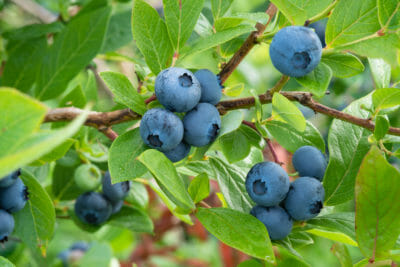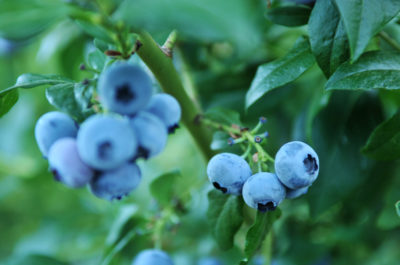|
Listen To The Article
|

With the right conditions, you should be able to grow blueberries as easily as other fruits and vegetables.
Blueberries have a reputation for being difficult to grow, but if you have the right growing conditions, they’re no more difficult than other fruits and vegetables. To grow blueberries, you need a soil pH between 4.6 and 5.5. Most of the East Coast, the South, and the Pacific Northwest have acidic soil, but if you live elsewhere, soil pH can be a challenge.
Blueberries need moist but well-draining soil. They don’t tolerate heavy soils that stay soggy. They also do best with some humidity. In dry, windy areas, they tend to dry out in the winter and suffer bud damage. Blueberries grow best in full sun to partial shade. In the north, they should be planted in an area that gets six to eight hours of sunlight daily. In warm, southern regions, they can take partial shade. An area that gets four to six hours of sunlight is fine.
How To Grow Blueberries: Choosing A Variety
Besides giving your blueberries the ideal cultural environment, spend some time carefully choosing the varieties for your berry patch. Blueberries produce better yields if planted with a pollinator, so you’ll need two varieties. Northern highbush blueberries, as the name implies, are adapted to cold, northern climates. They grow 5 to 10 feet tall, although some dwarf cultivars are available. Popular varieties include Bluecrop, Blueray, Jersey, Elliott, Legacy, Chandler, and Duke.
Southern highbush blueberries are adapted for the warm, humid conditions of the South. Commonly grown varieties include Morrow, Murphy, Bounty, and Blueridge.
Rabbiteye blueberries are native to the southeastern United States. These blueberry plants produce smaller, sweeter blueberries than the highbush types. They’re also more adaptable to growing conditions and tolerate drier, more alkaline soil. One drawback to rabbiteye blueberries is that they bloom earlier in the spring than highbush types, which makes them more vulnerable to frost damage. Try Climax, Powderblue, or Premier.
How To Grow Blueberries: Planting And Early Care
Buy blueberry plants from a reputable nursery or online vendor. Choose two or three-year-old plants that stand at least 12 to 36 inches tall. Plant bare-root blueberries in early spring while they’re still dormant. Plant potted plants anytime from spring through early fall. However, planting them only in spring or only in fall is usually best because the plants stay moister.
Space blueberry plants at least 5 feet apart, depending on the mature size of your plants, and mulch them with 3 to 4 inches of wood chips. Keep them well watered during the first season as they establish roots.
After planting, prune bare-root plants to remove up to two-thirds of the growth. Prune potted plants by half, leaving two to three strong stems. Remove any flower buds that appear during the first season to encourage strong root growth. This early pruning will produce more vigorous yields in future years.
About six weeks after planting, fertilize the blueberries with 1 tablespoon granular 10-10-10 fertilizer or an acidic fertilizer made for azaleas. Spread the fertilizer in a 12-inch circle around the base of the plant and water it in well.
How To Grow Blueberries: Ongoing Care
Blueberries won’t produce a significant crop for at least the first two or three years. Your early patience pays off, though, because blueberry bushes can live for 50 years or more. Continue to water blueberries throughout the growing season so the soil stays moist 2 inches beneath the soil surface. Additionally, drought conditions will reduce yields.
In cold areas, wrap blueberries in the winter with old sheets or burlap so they don’t dry out. Replace mulch every few years as it thins. Mulches conserve soil moisture and keep weed growth down so plants stay healthier with less effort.
Fertilize mature plants with 1 cup of 10-10-10 fertilizer per plant each spring, as new growth emerges. Spread the fertilizer in a 3-foot circle under the shrub.
New Natural Fertilizer Doubles Garden Production!
During the first three to four years after planting, blueberry bushes should be pruned each spring to remove most of the flower buds. Heavy fruiting on young plants can cause permanent bending and damage. Once the bushes stand 4 to 5 feet tall, their canes are strong enough to bear fruit. Thereafter, prune them each spring to remove old, dead, or diseased canes or those that rub against each other. Prune them back to outward facing buds, if necessary, to control their height. Rejuvenate older bushes by cutting out one-third of the oldest canes every spring.
How To Grow Blueberries: Solutions For Alkaline Soil

If you thought you couldn’t grow blueberries out West or in the Midwest, get ready to change your mind.
In the past, gardeners in the Midwest and western states have found growing blueberries to be challenging or impossible. Alkaline soil, so prevalent in many of these areas, was usually to blame, along with cold, dry conditions. When blueberries are planted in alkaline soil, they can’t take up iron. The leaves develop chlorosis or yellowing of the leaves with green veins. Soon, the plants wither and die, usually within one or two seasons.
It’s possible to acidify your soil with applications of sulfur, but the results are temporary and work best if you have a soil pH of 6.0 or less. Researchers at the Colorado State University Extension have found a few blueberry solutions for the western gardener. If you thought you couldn’t grow blueberries, get ready to change your mind.
Joel Reich, a horticulture expert at the Colorado State University Extension, has successfully grown blueberries in sphagnum peat moss. Peat moss is naturally acidic, drains well, and provides the perfect medium for growing success. He punches large drainage holes in plastic-wrapped bales of peat moss. He then sinks these bales into the ground and cuts openings in the top, where he then places the blueberry plants. Peat moss holds up to three times its weight in water, although it comes in a very dry form. Allow a hose to run slowly in the bales for at least an hour to thoroughly moisten the mixture. Once it is moistened, it will retain water well.
Another option, also developed by CSU, is a bit more complicated. Mix 40 percent coir, 40 percent peat moss, and 20 percent perlite to get a light, acidic potting mix. Dig a hole in the ground and place a large pot in the ground. Place a second pot inside the first. Fill this pot with the acidic potting mix and plant the blueberry plant. Advocates of this method say that the double pot method helps insulate the soil from temperature changes and completely isolates the plant’s roots from native, alkaline soil.
Regardless of which method you choose, once planted, the blueberries should be mulched with three to four inches of wood chip mulch. Also, treat them with an acidic fertilizer in the spring and summer. Wrap them in burlap in the winter to protect them from cold, drying winds.
You may also enjoy reading an additional Off The Grid News article: Natural Fertilizer Can Dramatically Improve “Survival Garden” Food Production
Do you have any additional thoughts or tips about how to successfully grow blueberries in your garden? Let us know in the comments below.
 Off The Grid News Better Ideas For Off The Grid Living
Off The Grid News Better Ideas For Off The Grid Living




